2. 中国人民解放军第285医院, 河北 056000
2. Department of Orthopaedics, 285 Hospital of Chinese PLA, Handan 056000, Hebei, China
青少年特发性脊柱侧凸(AIS)矫正率的提高得益于椎弓根螺钉的应用,这使得AIS在冠状面和横断面上的力线能够很好地重建。全椎弓根螺钉带来强大矫形力的同时,同样也带来系列相关并发症,如术后胸椎生理弯曲减小[1-2]。近年来,AIS矢状面力线的重建越来越受到外科医师的重视,因为良好的矢状面平衡与患者生存质量显著相关[3]。许多因素均可影响AIS患者术后矢状面平衡,如融合节段选择[4]、医师操作技术水平[5]和术前矢状面参数[6]。对于胸椎结构性侧凸的患者,胸椎生理弯曲较正常人群要小,一般 < 20°,使术后胸椎生理弯曲不足风险增加。既往研究表明,矫形棒材料是影响AIS矢状面矫形效果的重要因素[7]。本研究通过建立有限元模型,模拟AIS矫形手术,探讨不同材料、不同预弯弧度矫形棒在AIS矢状面平衡重建中的作用。
1 资料与方法 1.1 T1至骶骨有限元模型的建立选择1例AIS患者,女,14.3岁,身高162 cm,体质量51 kg。术前正位X线片测量T1 ~ 6 Cobb角为24°,T6 ~12 Cobb角为48°;矢状面测量胸椎后凸T2 ~12为11°,T10 ~ L2为-6°,腰椎后凸为51°。采用0.8 mm薄层CT扫描T1至骶骨,得到dicom格式图像数据。图像导入Mimics软件(Materialise公司,比利时),输出格式为stl的模型数据。将stl数据导入Geomagic Studio软件(Geomagic公司,美国)对模型进行修补和边界调整。使用SolidWorks软件(SolidWorks公司,美国)根据上下椎体轮廓构建椎间盘形状,髓核与纤维环成分比为3:2。仿真模拟前后纵韧带,根据解剖结构特点构建其余韧带。根据骨质的CT值(亨氏单位,Hu)差异,使用Mimics软件进行对应赋值,计算各结构密度(ρ),ρ(kg·m-3)=1.067×CT值+131。进一步计算各结构弹性模量(E),E=009 882×ρ1.56。泊松比为0.30。模型中各结构赋值见表 1。
|
|
表 1 各结构赋值 Table 1 Assignment of different structures |
荷载与边界条件设定。限制T1椎体上终板和骶骨各个方向自由度,模拟人体直立状态脊柱所受负荷,最终躯干上身体质量平均施加在每一个节段上。所建立的模型中,骨组织、终板和韧带分别应用实体单元、壳单元和仿真单元。模型包括691 271个单元,其中实体单元、壳单元以及仿真单元计数分别为667 459、62 838和575(图 1)。
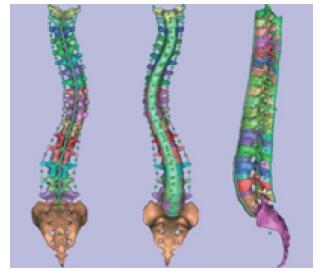
|
图 1 AIS有限元模型 Figure 1 Finite element model of AIS |
构建的有限元模型与AIS患者术前X线片具有良好的几何相似性,Wilcoxon检验提示椎体各重心到骶骨中垂线距离一致。前屈、后伸、左旋和右旋加载实验表明,本研究建立的AIS模型与Panjabi等[8]的报道一致。本模型采用实物加载,与既往建立的模型[9]相比更接近实体力学特性(图 2),可用于不同材料、不同预弯曲度矫形棒对AIS矢状面平衡重建的研究。

|
a:前屈 b:后伸 c:左旋 d:右旋 a:Forward flexion b:Backward extension c:Left rotation d:Right rotation 图 2 椎体施加荷载时的位移图 Figure 2 Displacement diagram of vertebra under loading |
采用Solidworks软件设定螺钉的材料属性,ABAQUS软件进行力学加载运算。由于CT中没有内固定材料数据,实验采用ABAQUS软件进行模拟。上胸椎椎弓根螺钉的长度和直径为25.00 mm和3.50 mm,胸椎中段为30.00 mm和4.00 mm,下胸椎为40.00 mm和5.50 mm,腰椎为45.00 mm和6.00 mm。钉棒间采用面与面接触,相对摩擦系数为0.52。椎弓根螺钉的弹性模量与泊松比分别设定为11 000 MPa和0.3。钉棒采用四面体模拟设计,限定置入后螺钉所有方向自由度。
矫形方式为棒平移矫形,边界条件为约束T1椎体上部在X、Y轴方向上的自由度,同时约束骶骨和骨盆的自由度。矫形上棒时将棒预弯一定角度,凹侧上棒矫形。手术节段为T2 ~ L2。上棒矫形过程中没有考虑肌肉和胸廓对手术的影响。术后测量胸椎、胸腰段和腰椎曲度,同时测量螺钉对应的拔出力。
根据硬度不同设定矫形棒材料为钴铬合金和钛合金,棒的直径均为6.35 mm。钛合金棒弹性模量为11 000 Mpa,泊松比为0.30;钴铬合金棒弹性模量为23 900 Mpa,泊松比为0.35。分别比较2种矫形棒术后胸椎后凸、胸腰交界后凸和腰椎前凸的变化以及椎弓根螺钉拔出力。
1.3 不同预弯曲弧度钛合金棒手术模拟在前述AIS模型基础上,采用钛合金棒平移矫形。增大棒预弯弧度为40°,比较采用不同预弯弧度(28°和40°)矫形棒对AIS矢状面力线及螺钉拔出力的影响。
2 结果当矫形棒预弯弧度为28°时,钛合金棒矫形后胸椎后凸为12°,胸腰段为3°,腰椎前凸为38°;钴铬合金棒矫形后胸椎后凸为25°,胸腰段为3°,腰椎前凸为38°(图 3),说明钴铬合金棒能够更好地恢复患者胸椎后凸和腰椎前凸(图 4),但使用钴铬合金棒时,椎弓根螺钉拔出应力显著增加(图 5)。当钛合金棒预弯弧度为40°时,胸椎后凸恢复到27°,显著优于预弯弧度为28°时,同时螺钉拔出应力显著增加(图 6~8)。
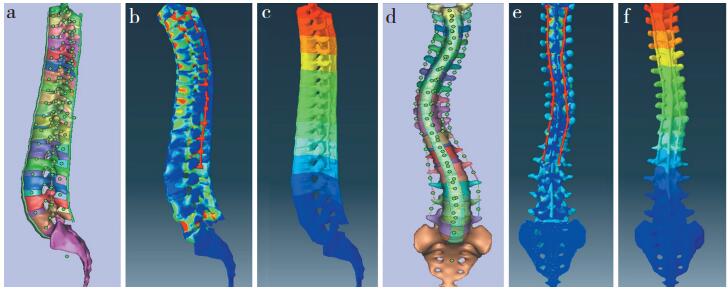
|
a:术前脊柱矢状面视图 b:钴铬合金棒矫形后脊柱矢状面位移云图 c:钛合金棒矫形后脊柱矢状面位移云图 d:术前脊柱冠状面视图 e:钴铬合金棒矫形后冠状面位移云图 f:钛合金棒矫形后位移云图 a:Sagittal plane of spine before surgery b:Cloud chart of spine in sagittal plane after surgery with cobalt-chromium alloy rod c:Cloud chart of spine in sagittal plane after surgery with titanium alloy rod d:Coronal plane of spine before surgery e:Cloud chart of spine in coronal plane after surgery with cobalt-chromium alloy rod f:Cloud chart of spine in coronal plane after surgery with titanium alloy rod 图 3 不同材料矫形棒的矫形位移效果云图(预弯弧度28°) Figure 3 Cloud chart of orthopedic displacement of different material rods(pre-bending curve 28°) |
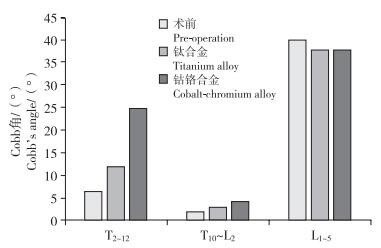
|
图 4 矫形后胸腰椎矢状面参数的比较(预弯弧度28°) Figure 4 Comparison of sagittal parameters of thoracolumbar spine after orthopaedics(pre-bending curve 28°) |

|
图 5 螺钉在各椎体相应拔出力的比较(预弯弧度28°) Figure 5 Comparison of screw pullout forces at different levels(pre-bending curve 28°) |

|
a:术前脊柱矢状面视图 b:预弯弧度为28°时矫形后脊柱矢状面位移云图 c:预弯弧度为40°时矫形后脊柱矢状面位移云图 a:Sagittal plane of spine before surgery b:Cloud chart of spine in sagittal plane after surgery with 28° pre-bending curve c:Cloud chart of spine in sagittal plane after surgery with 40° pre-bending curve 图 6 不同预弯弧度钛合金棒矫形位移效果云图 Figure 6 Cloud chart of orthopedic displacement of titanium alloy rods with different pre-bending curves |
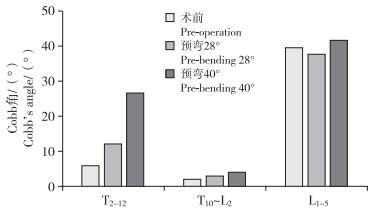
|
图 7 使用不同预弯弧度的钛合金矫形棒术后胸腰椎矢状面参数比较 Figure 7 Comparison of sagittal parameters between titanium alloy rods with different pre-bending curves |
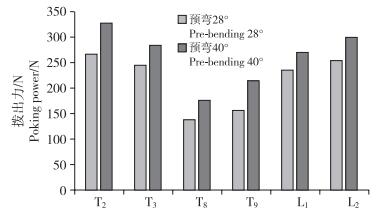
|
图 8 使用不同预弯弧度钛合金矫形棒时螺钉在各椎体相应拔出力比较 Figure 8 Comparison of screw pullout forces between titanium alloy rods with different pre-bending curve |
随着脊柱内固定器械的发展,全椎弓根螺钉强大的矫形力实现了AIS脊柱在冠状面、横断面和矢状面力线的矫正[10]。相应的手术方式也不断出现,从起初的单凹侧撑开凸侧加压到今天的截骨矫形术等[11]。有研究表明,脊柱矢状面平衡和患者生存质量具有显著相关性,恢复AIS患者胸腰椎生理曲度具有重要意义[12]。许多因素均可影响AIS术后矢状面平衡,不同材料矫形棒的矢状面重建效果不同。临床研究发现,硬度较高的钴铬合金棒能够更好地恢复患者胸椎生理曲度[13-14],也能更好地维持冠状面和矢状面的矫形效果[7]。
本研究采用有限元模型模拟侧凸矫形手术,结果表明,矫形棒材料硬度相对较大时,胸椎后凸的重建效果更好。目前矫形棒的材料主要包括不锈钢、钛、钛合金和钴铬合金,不同材料的生物属性各异。不锈钢棒由于磁共振的兼容性差,已经很少使用。钛合金棒和钛棒具有生物力学优势,目前应用较多。钛棒钢度明显优于不锈钢棒,磁共振相容性和生物相容性好,抗疲劳性强。钴铬合金棒的刚度比钛棒和钛合金棒都要强,在同样的弹性回弹范围下矫形力更大,抗疲劳性更好[15]。因此,钴铬合金棒对于柔韧性非常差的脊柱畸形患者尤为适用。在本研究中,矫形棒预弯弧度同样为28°时,钴铬合金棒术后胸椎后凸恢复情况好于采用钛合金棒。既往临床研究也表明,钴铬合金棒能够更好地重塑矢状面平衡,同时也能够更好地维持矫形效果[7, 14]。需要注意的是,矫形棒的刚度过大会导致棒置入节段椎体压力负荷降低,骨钙丢失风险相对增加。既往研究报道,内固定硬度越大,邻近节段承受应力越大,术后发生邻近节段退变的风险越高[16]。本研究还发现,使用钴铬合金棒时螺钉拔出应力大于使用钛合金棒。因此,对于上下端椎体螺钉应力较大部位,在螺钉的选择和置入时应考虑到钴铬合金棒带来的强大剪切力和拔出力,建议手术时适当增加螺钉数量,并将螺钉恰当地分散在融合节段不同椎体。
本研究还发现,术前矫形棒预弯弧度会影响AIS矢状面平衡的恢复,适当增加矫形棒的胸段预弯弧度能够更好地维持矢状面矫形效果,与文献报道一致[17-18]。但是当预弯弧度增加时,也会导致螺钉拔出应力增加,同时矫形棒的抗疲劳性会显著下降,增加了断棒的风险[15]。目前手术医师在确定弯棒弧度时多由自身经验决定,本研究初步探讨了采用基于金属棒性质的有限元模型预测矫形棒预弯弧度,为个体化设计矫形棒预弯弧度及矫形棒材料选择提供了新思路。但本研究采用的是仿真模型,无法纳入患者体质量、柔韧性、骨骼发育等情况,其可行性仍需进一步验证。
| [1] | Ohrt-Nissen S, Hallager DW, Karbo T, et al. Radiographic and functional outcome in adolescent idiopathic scoliosis operated with hook/hybrid versus all-pedicle screw instrumentation-a retrospective study in 149 patients[J]. Spine Deform, 2017, 5(6): 401–408. DOI:10.1016/j.jspd.2017.05.002 |
| [2] | Murphy RF, Mooney JF 3rd. Complications following spine fusion for adolescent idiopathic scoliosis[J]. Curr Rev Musculoskelet Med, 2016, 9(4): 462–469. DOI:10.1007/s12178-016-9372-5 |
| [3] | 邢润麟, 张顺聪, 江晓兵. 脊柱矢状面失衡对骨质疏松性椎体压缩性骨折椎体成形术疗效的影响[J]. 脊柱外科杂志, 2017, 15(2): 106–110. DOI:10.3969/j.issn.1672-2957.2017.02.008 |
| [4] | Celestre PC, Carreon LY, Lenke LG, et al. Sagittal alignment two years after selective and nonselective thoracic fusion for Lenke 1C adolescent idiopathic scoliosis[J]. Spine Deform, 2015, 3(6): 560–565. DOI:10.1016/j.jspd.2015.05.002 |
| [5] | Monazzam S, Newton PO, Bastrom TP, et al. Multicenter comparison of the factors important in restoring thoracic kyphosis during posterior instrumentation for adolescent idiopathic scoliosis[J]. Spine Deform, 2013, 1(5): 359–364. DOI:10.1016/j.jspd.2013.06.002 |
| [6] | Wang F, Zhou XY, Xu XM, et al. Cervical sagittal alignment limited adjustment after selective posterior thoracolumbar/lumbar curve correction in patients with Lenke type 5C adolescent idiopathic scoliosis[J]. Spine (Phila Pa 1976), 2017, 42(9): E539–E546. DOI:10.1097/BRS.0000000000001906 |
| [7] | 杨武, 李志鲲, 翟骁, 等. 钴铬棒在青少年特发性脊柱侧凸矫形手术中的应用[J]. 脊柱外科杂志, 2015, 13(3): 129–134. DOI:10.3969/j.issn.1672-2957.2015.03.001 |
| [8] | Panjabi MM, Greenstein G, Duranceau J, et al. Threedimensional quantitative morphology of lumbar spinal ligaments[J]. J Spinal Disord, 1991, 4(1): 54–62. |
| [9] | 范建平, 王传锋, 魏显招, 等. 新型个体化三维矫形胸腰骶气囊支具的有限元研究[J]. 脊柱外科杂志, 2013, 11(6): 348–353. DOI:10.3969/j.issn.1672-2957.2013.06.008 |
| [10] | Kemppainen JW, Morscher MA, Gothard MD, et al. Evaluation of limited screw density pedicle screw constructs in posterior fusions for adolescent idiopathic scoliosis[J]. Spine Deform, 2016, 4(1): 33–39. DOI:10.1016/j.jspd.2015.07.010 |
| [11] | 潘显纬, 王建喜, 吴晓东, 等. 超声骨刀在退变性胸腰椎侧后凸畸形截骨矫形术中的应用[J]. 脊柱外科杂志, 2017, 15(2): 89–93. DOI:10.3969/j.issn.1672-2957.2017.02.005 |
| [12] | Benli IT, Ates B, Akalin S, et al. Minimum 10 years follow-up surgical results of adolescent idiopathic scoliosis patients treated with TSRH instrumentation[J]. Eur Spine J, 2007, 16(3): 381–391. DOI:10.1007/s00586-006-0147-3 |
| [13] | Angelliaume A, Ferrero E, Mazda K, et al. Titanium vs. cobalt chromium:what is the best rod material to enhance adolescent idiopathic scoliosis correction with sublaminar bands?[J]. Eur Spine J, 2017, 26(6): 1732–1738. DOI:10.1007/s00586-016-4838-0 |
| [14] | Lamerain M, Bachy M, Dubory A, et al. All-pedicle screw fixation with 6-mm-diameter cobalt-chromium rods provides optimized sagittal correction of adolescent idiopathic scoliosis[J]. Clin Spine Surg, 2017, 30(7): E857–E863. DOI:10.1097/BSD.0000000000000413 |
| [15] | Slivka MA, Fan YK, Eck JC. The effect of contouring on fatigue strength of spinal rods:is it okay to re-bend and which materials are best?[J]. Spine Deform, 2013, 1(6): 395–400. DOI:10.1016/j.jspd.2013.08.004 |
| [16] | Panagiotopoulou V, Hothi H, Aawar H, et al. Is there clinical evidence of galvanic corrosion in constructs with cocr rods and titanium screws?[J]. Global Spine J, 2017(2): 146S–147S. |
| [17] | Cidambi KR, Glaser DA, Bastrom TP, et al. Postoperative changes in spinal rod contour in adolescent idiopathic scoliosis:an in vivo deformation study[J]. Spine(Phila Pa 1976), 2012, 37(18): 1566–1572. DOI:10.1097/BRS.0b013e318252ccbe |
| [18] | Le Navéaux F, Aubin CE, Parent S, et al. 3D rod shape changes in adolescent idiopathic scoliosis instrumentation:how much does it impact correction?[J]. Eur Spine J, 2017, 26(6): 1676–1683. DOI:10.1007/s00586-017-4958-1 |
 2018, Vol.16
2018, Vol.16  Issue(6): 358-362
Issue(6): 358-362


